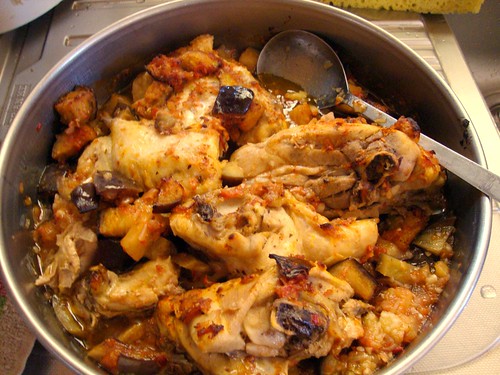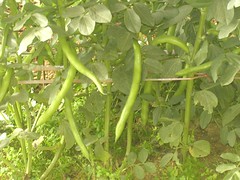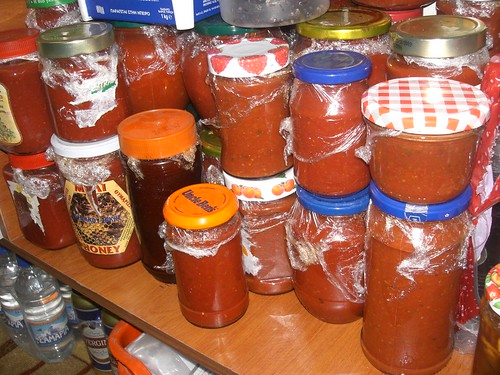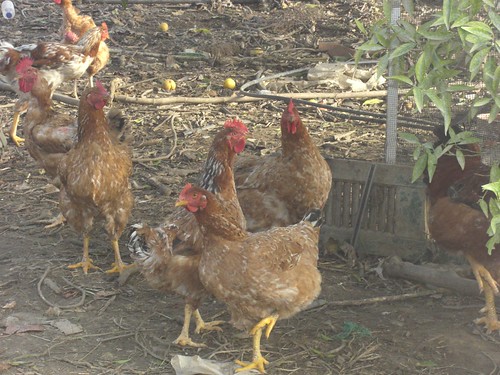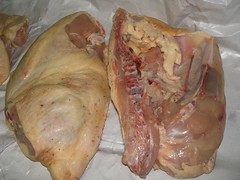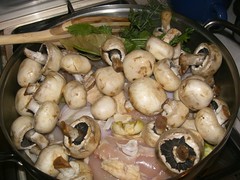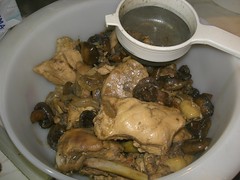Yes, broccoli again. I've uprooted all our broccoli plants, but I still have a freezer-shelf full of the stuff. It has occurred to me that we have been eating a lot of broccoli this winter, but this is for economy more than anything else. Instead of buying winter vegetables, I use our bumper crop of broccoli wherever I can. We have so much broccoli from the garden, that I par-boil a large pot of broccoli twice a week (yes, really), which gives me a chance to use it in different ways when I come home from work, eg stir-fries, soups, fritters, etc. I'm so glad I'm a really good cook, because I can cook broccoli this often and make sure that my while family still manages to enjoy their meal. We have had it in so many different forms, that they never complain. I'm that creative. Even the dog eats broccoli mixed in with her food. And if you know a thing or two about broccoli, it is regarded as a superfood.

I knew that from a long time ago, when one of our Algerian students at the Institute researched the "Genetic and epigentic control of glucosinolates pathways synthesis in broccoli", whatever that means (I proofread a lot of stuff which I don't always understand), a thesis which contained a lot of research on the benefits of broccoli in the diet. Since then, broccoli is described in the internet press as a nutritional show stopper, an anti-cancer agent, a tumour reducer, an age suppresor, a vitamin-packed agent with more Vitamin C than an orange, among others. Well, I'm glad to hear all that, because we really do eat a lot of broccoli, and it just might help us all to keep up our good health, now that Greece has no public health system (just yet, apart from hospitals). We don't lead the kind of life that gives us the privilege of making proclamations like "I'm President of the United States, and I'm not going to eat any more broccoli!" like George Bush did. But lucky for us, broccoli keeps us healthy.
This broccoli soup was made on the go, with little time to spare for 'real' cooking; I was harvesting and processing celery for the freezer, at the same time as picking spinach from among the tall and rather overgrown nettles that have now surrounded all the spinach plants. But don't take my soft whinge seriously: the winter garden is really easy to maintain. The plants seem to grow by themselves, they rarely need much care, and all I do is harvest. It's really not as difficult as it may sound. I just wish I could be doing something else instead, like work on the project, which is underway - slowly, slowly...
I made this amazing soup last Friday, despite my aching bones, after a very tiring week, as I thought about the three-day weekend that we are now in the middle of (it's Kathara Deftera tomorrow). Perhaps everyone loved it so much because it was a cold night, but I have a feeling that they liked it because it was really delicious. it has a pungent taste because fo teh way I used the garlic. Normally I cook it in some way, eg sauteeing in oil before being added to a meal. In this recipe, the garlic is not cooked at all, so it has a strong but fresh flavour.
You need:
4 chicken backs, with necks
4-5 medium potatoes
about 3 cups of broccoli cut into bite sized individual heads
2 large cloves of garlic
salt, pepper and oregano

Boil the chicken backs, broccoli and peeled potatoes in a large pot of water, till the potatoes are soft. Remove the chicken, broccoli and potatoes from the pot. Puree 3 potatoes with the garlic and some of the stock water (strained to remove impurities from the chicken) in a blender. Pour the puree into another pot. Strain all the remaining liquid into the pot with the puree. Add the chicken meat (which you shredded from the chicken backs and necks), and all the seasonings. Chop the remaining potatoes and all the broccoli into small pieces. Mix well to form a blended soup. Heat through.
Serve the soup piping hot, with crusty bread. It will not make you feel poor as you think that you are cooking again with broccoli which you grew yourself; it will make you feel somewhat superior, having so much superfood at your disposal.
©All Rights Reserved/Organically cooked. No part of this blog may be reproduced and/or copied by any means without prior consent from Maria Verivaki.

The broccoli season is over - my neighbour's broccoli plants (the ones with the yellow flowers) are going the way mine did and they need uprooting.
I knew that from a long time ago, when one of our Algerian students at the Institute researched the "Genetic and epigentic control of glucosinolates pathways synthesis in broccoli", whatever that means (I proofread a lot of stuff which I don't always understand), a thesis which contained a lot of research on the benefits of broccoli in the diet. Since then, broccoli is described in the internet press as a nutritional show stopper, an anti-cancer agent, a tumour reducer, an age suppresor, a vitamin-packed agent with more Vitamin C than an orange, among others. Well, I'm glad to hear all that, because we really do eat a lot of broccoli, and it just might help us all to keep up our good health, now that Greece has no public health system (just yet, apart from hospitals). We don't lead the kind of life that gives us the privilege of making proclamations like "I'm President of the United States, and I'm not going to eat any more broccoli!" like George Bush did. But lucky for us, broccoli keeps us healthy.
This broccoli soup was made on the go, with little time to spare for 'real' cooking; I was harvesting and processing celery for the freezer, at the same time as picking spinach from among the tall and rather overgrown nettles that have now surrounded all the spinach plants. But don't take my soft whinge seriously: the winter garden is really easy to maintain. The plants seem to grow by themselves, they rarely need much care, and all I do is harvest. It's really not as difficult as it may sound. I just wish I could be doing something else instead, like work on the project, which is underway - slowly, slowly...
I made this amazing soup last Friday, despite my aching bones, after a very tiring week, as I thought about the three-day weekend that we are now in the middle of (it's Kathara Deftera tomorrow). Perhaps everyone loved it so much because it was a cold night, but I have a feeling that they liked it because it was really delicious. it has a pungent taste because fo teh way I used the garlic. Normally I cook it in some way, eg sauteeing in oil before being added to a meal. In this recipe, the garlic is not cooked at all, so it has a strong but fresh flavour.
You need:
4 chicken backs, with necks
4-5 medium potatoes
about 3 cups of broccoli cut into bite sized individual heads
2 large cloves of garlic
salt, pepper and oregano

Boil the chicken backs, broccoli and peeled potatoes in a large pot of water, till the potatoes are soft. Remove the chicken, broccoli and potatoes from the pot. Puree 3 potatoes with the garlic and some of the stock water (strained to remove impurities from the chicken) in a blender. Pour the puree into another pot. Strain all the remaining liquid into the pot with the puree. Add the chicken meat (which you shredded from the chicken backs and necks), and all the seasonings. Chop the remaining potatoes and all the broccoli into small pieces. Mix well to form a blended soup. Heat through.
Serve the soup piping hot, with crusty bread. It will not make you feel poor as you think that you are cooking again with broccoli which you grew yourself; it will make you feel somewhat superior, having so much superfood at your disposal.
©All Rights Reserved/Organically cooked. No part of this blog may be reproduced and/or copied by any means without prior consent from Maria Verivaki.













